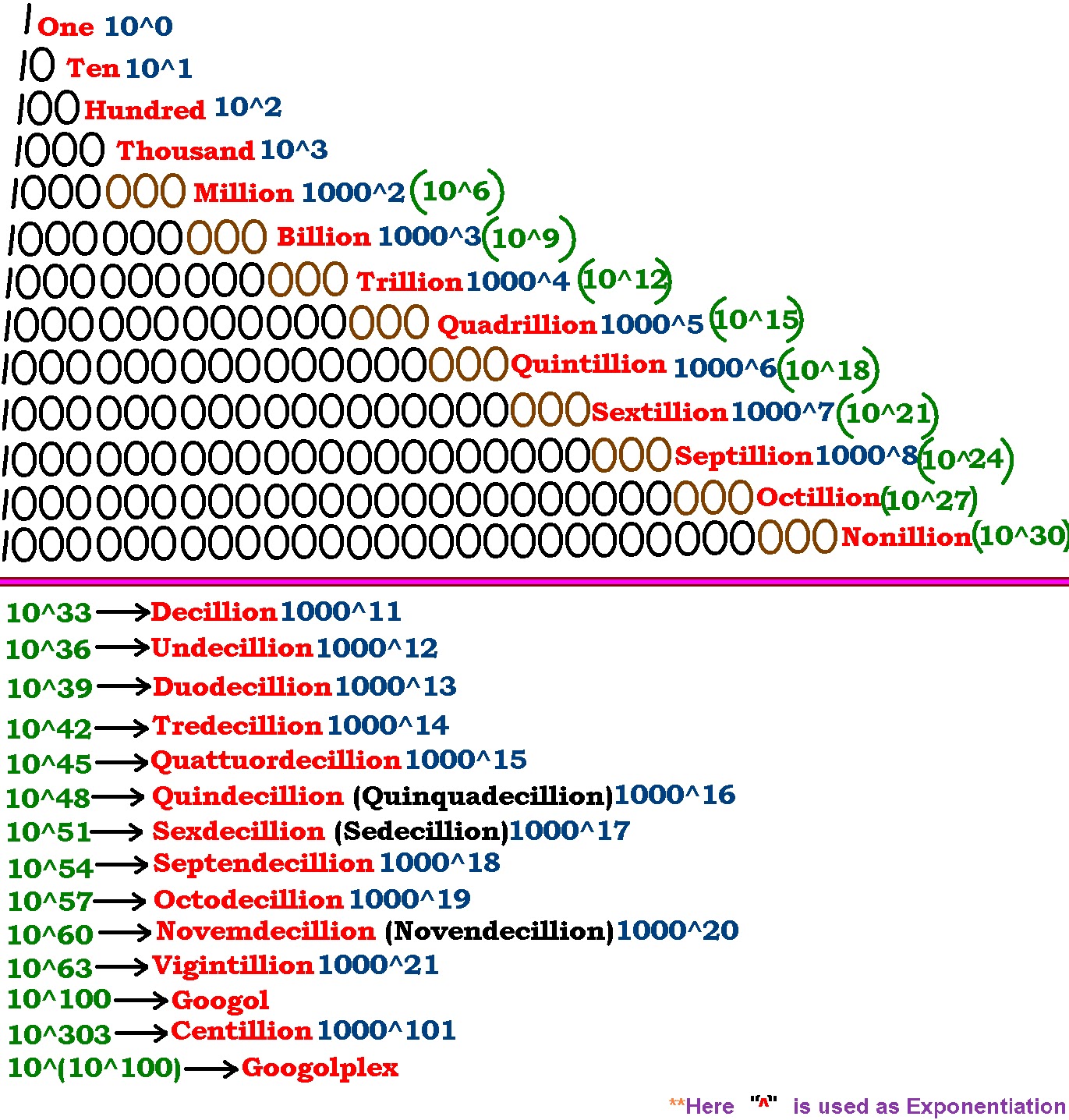Unveiling The Numbers After A Trillion: A Journey Beyond The Familiar
Alright folks, let's dive into something that’s truly mind-blowing—what happens after a trillion? Imagine sitting in a room filled with numbers so massive they make your brain itch. We’re talking about numbers so big they could crush your calculator if you tried to type them in. So, buckle up because we’re about to embark on a journey through the stratosphere of mathematics, where the numbers after a trillion reign supreme.
When we think about numbers, most of us rarely go beyond the millions or billions. Sure, we’ve all heard of trillions, especially when it comes to government budgets or global GDPs. But what comes after that? It’s not just some random concept; these numbers have real-world applications and significance. From scientific calculations to astronomical measurements, understanding what lies beyond a trillion opens doors to some truly fascinating insights.
Now, if you're like me, you might be scratching your head thinking, "Do I really need to know this?" The answer is yes—you do! Whether you're a math enthusiast, a curious mind, or someone who simply wants to expand their knowledge, understanding the numbers after a trillion will give you a newfound appreciation for the scale of the universe and everything in it. So, let’s get started, shall we?
- Discover The Enchanting Beauty Of Golden Steer Forest Park
- Experience The Excitement Of The Texas Longhorns Womens Basketball Season
Why Understanding Numbers After a Trillion Matters
Let's face it—numbers are everywhere. They’re in your bank account, the distance between planets, and even the number of grains of sand on Earth. But when you start venturing into the realm of numbers after a trillion, you're stepping into a world that defies imagination. These aren't just random figures; they’re essential for understanding the vastness of the universe and the complexity of modern science.
For instance, did you know that the observable universe is estimated to contain around 2 sextillion stars? That’s right—2 followed by 21 zeros. Or how about the fact that the human brain has approximately 100 quadrillion neural connections? These numbers aren’t just cool to say; they’re crucial for fields like astrophysics, biology, and economics. Understanding them gives us a better grasp of the world around us.
Breaking Down the Scale: Numbers Beyond Trillion
So, what exactly comes after a trillion? Let’s break it down step by step:
- Oakland As Baseball A Legacy Of Excellence And Innovation
- Understanding The Role Of Agencia Federal De Gestioacuten De Emergencias In Emergency Preparedness
- Trillion: 1,000,000,000,000
- Quadrillion: 1,000,000,000,000,000
- Quintillion: 1,000,000,000,000,000,000
- Sextillion: 1,000,000,000,000,000,000,000
See how the numbers grow exponentially? Each step adds three more zeros, and before you know it, you're dealing with numbers so large they’re almost impossible to comprehend. But hey, that’s what makes it so exciting!
Applications of Numbers After a Trillion
Alright, so we’ve established that these numbers are big—but what do they actually do? Turns out, they’re more than just fun facts to impress your friends at parties. These numbers have practical applications in various fields:
1. Astronomy
In astronomy, numbers after a trillion are used to measure distances in space. For example, the Andromeda Galaxy is about 2.5 million light-years away from Earth. That’s 2.5 quintillion kilometers! Without these massive numbers, scientists wouldn’t be able to accurately describe the vastness of the universe.
2. Economics
Global economies often deal with numbers in the trillions and beyond. Think about the U.S. national debt, which has surpassed $31 trillion. Or consider the global GDP, which is measured in the tens of trillions. These numbers help policymakers and economists understand the scale of financial systems.
3. Technology
With advancements in computing, we’re now able to process data at unprecedented speeds. Supercomputers, for instance, can perform quadrillions of calculations per second. This capability is crucial for tasks like weather forecasting, medical research, and artificial intelligence development.
A Brief History of Large Numbers
Believe it or not, humans have been fascinated by large numbers for centuries. Ancient civilizations like the Greeks and Romans had their own ways of describing massive quantities. However, it wasn’t until the 17th century that mathematicians like John Wallis introduced the concept of infinity, paving the way for modern number systems.
Today, we use the International System of Units (SI) to standardize large numbers. This system makes it easier to communicate and compare values across different fields. For example, instead of saying "a million million," we can simply say "quadrillion." It’s all about making things simpler and more efficient.
How to Visualize Numbers After a Trillion
Let’s be honest—visualizing numbers this large is no easy feat. Your brain wasn’t exactly designed to comprehend figures with 20 or more zeros. But don’t worry; there are ways to make it more relatable:
- Imagine stacking $100 bills. A trillion dollars would reach about 67 miles high. Now multiply that by a thousand for a quadrillion!
- Think about time. A trillion seconds is roughly 31,700 years. A quadrillion seconds? That’s over 31 million years.
- Consider space. The diameter of the Milky Way galaxy is about 100,000 light-years, or approximately 1 quintillion kilometers.
These analogies help put things into perspective and make the numbers feel a little less intimidating.
The Science Behind Large Numbers
Large numbers aren’t just random inventions; they’re based on solid mathematical principles. The concept of exponential growth, for example, explains why numbers increase so rapidly. Each step up the ladder adds three more zeros, creating a snowball effect that quickly spirals out of control.
Mathematicians have also developed tools to work with these numbers, such as scientific notation. Instead of writing out every zero, we can express numbers like 1 quintillion as 1 x 10^18. This makes calculations much easier and more manageable.
Fun Facts About Numbers After a Trillion
Let’s take a break from the serious stuff and have some fun with these massive numbers:
- The word "quadrillion" was first used in English in the late 17th century.
- A googol, which is 1 followed by 100 zeros, was coined by a nine-year-old boy in 1938.
- The largest named number is the googolplex, which is 1 followed by a googol of zeros. That’s so large it can’t even be written out in full!
Who knew math could be so entertaining?
Challenges of Working with Large Numbers
While large numbers are fascinating, they also pose unique challenges. For one, they’re difficult to visualize and comprehend. Additionally, working with them requires specialized tools and techniques. Even computers struggle to handle numbers beyond a certain point, leading to issues like overflow errors.
Despite these challenges, mathematicians and scientists continue to push the boundaries of what’s possible. Through innovation and creativity, they find ways to harness the power of large numbers for the benefit of humanity.
Conclusion: Embracing the Infinite
As we wrap up our journey through the numbers after a trillion, it’s clear that these figures play a vital role in our understanding of the world. From measuring the stars to calculating economic growth, they help us make sense of the universe and everything in it.
So, the next time someone asks you what comes after a trillion, you’ll know exactly what to say. And who knows? Maybe you’ll even inspire someone else to explore the wonders of mathematics. After all, the possibilities are truly endless.
Now, it’s your turn. Leave a comment below and let me know what you think about these mind-blowing numbers. Or better yet, share this article with a friend and spread the knowledge. Together, we can unlock the mysteries of the universe, one number at a time.
Table of Contents
- Why Understanding Numbers After a Trillion Matters
- Breaking Down the Scale: Numbers Beyond Trillion
- Applications of Numbers After a Trillion
- A Brief History of Large Numbers
- How to Visualize Numbers After a Trillion
- The Science Behind Large Numbers
- Fun Facts About Numbers After a Trillion
- Challenges of Working with Large Numbers
- Conclusion: Embracing the Infinite



Detail Author:
- Name : Mohamed Predovic
- Username : ellen78
- Email : gwaters@roberts.org
- Birthdate : 1996-11-29
- Address : 456 Hahn Knolls Daishahaven, TX 75212
- Phone : +1-640-748-5667
- Company : Ziemann-Mraz
- Job : Medical Equipment Repairer
- Bio : Consequuntur facere placeat nihil sit. Ratione consequatur ea itaque. Perferendis dolores deserunt voluptatibus provident. Fugit molestiae aliquid est deleniti nostrum eaque.
Socials
facebook:
- url : https://facebook.com/grantl
- username : grantl
- bio : Deserunt et accusantium similique veritatis.
- followers : 476
- following : 1229
instagram:
- url : https://instagram.com/lgrant
- username : lgrant
- bio : Modi tempore et qui omnis ullam. Ducimus dolore odit dolore et molestias.
- followers : 5573
- following : 1951
linkedin:
- url : https://linkedin.com/in/lacey8708
- username : lacey8708
- bio : Enim voluptas aut dolorem deleniti quis.
- followers : 488
- following : 1421